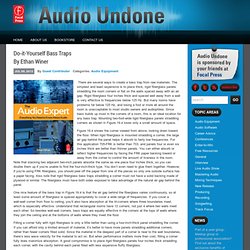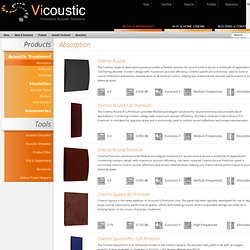

Do-it-Yourself Bass Traps By Ethan Winer. By Guest Contributor Categories: Audio Equipment There are several ways to create a bass trap from raw materials.

The simplest and least expensive is to place thick, rigid fiberglass panels straddling the room corners or flat on the walls spaced away with an air gap. Rigid fiberglass four inches thick and spaced well away from a wall is very effective to frequencies below 125 Hz. But many rooms have problems far below 125 Hz, and losing a foot or more all around the room is unacceptable to most studio owners and audiophiles. Since bass builds up most in the corners of a room, this is an ideal location for any bass trap. Figure 19.4 shows the corner viewed from above, looking down toward the floor.
One nice feature of the bass trap in Figure 19.4 is that the air gap behind the fiberglass varies continuously, so at least some amount of fiberglass is spaced appropriately to cover a wide range of frequencies. Www.bobgolds.com/AbsorptionCoefficients.htm. 0.00 = no absorbtion. 0.50 = 50% absorbtion. 1.00 = 100% absorbtion. Measurements are done according to a standard test method such as ASTM C423 or ISO. "In some cases, the measured sound absorption coefficient is greater than 1.00. As recommended by the test method, these values are reported as measured and not adjusted.
" "Differences in coefficients of less than 0.15 are not significant. " "The absorption coefficients that are typically published for acoustical materials are found using the reverberation chamber method. Owens Corning 700 series Rigid Fiberglass Owens Corning I'm unable to find Absorption Coefficient information on SOFTR Aeroflex Plus Acoustical Duct Liner (rolls, black on one side). Owens Corning Fiberglass Batts (fluffy pink), on the wall, and 16" from the wall Roxul Rigid Rockwool Rockwool.com Note, Roxul may be a Canadian/USA subsiduary of Rockwool.
BBC 1992-10.pdf. Johns Manville or here IIG Intelligent Insulation (Calsite/Johns Manville Joint Venture) CertainTeed Knauf. How I Built My Acoustic Panels - Gearslutz.com. Here's how I built my acoustic panels: For the walls, I went with 2" thickness; for the ceiling, I went with 4" thickness. 2'x4'x2" sheets of 703 Fiberglass (Owens Corning).

For both panel sizes, I nailed together two pieces of wood, same thickness as the fiberglass sheet(s), to create 90 degree angles for all of the corners. Gazebo lattice wood was then stapled to the angles, creating one side of support. Then I set the fiberglass panel(s) in and stapled lattice wood on top of that, securing the fiberglass in place. Next up, I wrapped the panels in Guilford of Maine Fabric, using a staplegun to attach the fabric to the back of the lattice wood. Eye hooks were then screwed into the top corners; L-shaped hangers screwed into the wall, both top and bottom. Building my first tuned trap (60hz). Any tips/guidelines? - Gearslutz.com.
SuperPanel bass trap design - a better way? - Gearslutz.com. Jesus guys.. this thread is a mess!

Quote: Originally Posted by Icecube1 you will find most pros using "actual" measurement data in preference. True! For low frequency absorption ie below 150Hz, thick layers (300mm ++) of low flow resistivity material (fluffy loft insulation) produce the best results. 300mm of fluffy will still underperform. Originally Posted by atledreier Rockwool is WAY too dense to work in those thicknesses. False. I've modelled the four steps.. You see there is virtually no difference, so a single 4" flat on the wall is almost as effective as this entire contraption. You know you're on the wrong track when you're getting those kind of answers! Originally Posted by OpusOfTrolls Rigid insulation batts are usually too high of GFR for 12" thickness. False! Originally Posted by AjD This discussion has convinced me that the sensible approach for my bass traps is going to be floor-to-ceiling 4" corner straddlers..
Tim's Limp Mass Bass Absorbers - Page 7. The theory is that they need to be airtight.

However if you trawl through G.E.'s research you will find all sorts of unexplained behaviour. e.g. Empty boxes outperforming sealed designs. It is worth remembering that we simply don't have trustworthy test evidence. There have been some singular test/explorations but nothing rigorous or repeatable. I am not aware of tests which compare such boxes or other traps with and without fronts of various types. Newell uses large areas of 'deadsheet' in his compound full range traps. If one were to hang a 1x2.5M sheet of MLF across a corner, I would be very surprised if it did not have an LF absorbing effect. Absorption. Cinema Round The Cinema range of absorption panels provides a flexible solution for sound control across a multitude of applications.

Combining discrete, modern design with maximum acoustic efficiency, Cinema panels are commonly used to control sound reflections and excess reverberation in all kinds of rooms, helping you maximize the acoustic performance of your listening space. 0.850 dB Euroclass F Medium Frequencies Absorption Cinema Round 120 Premium The Cinema Round Pro Premium provides flexible and elegant solutions for sound control across a multitude of applications. 0.950 dB Cinema Round Premium Cinema Premium panels provide flexible and elegant solutions for sound control across a multitude of applications.
Cinema Square 60 Premium Cinema Square is the latest addition to Vicoustic's Premium Line.